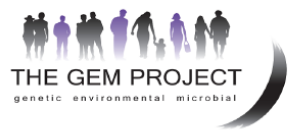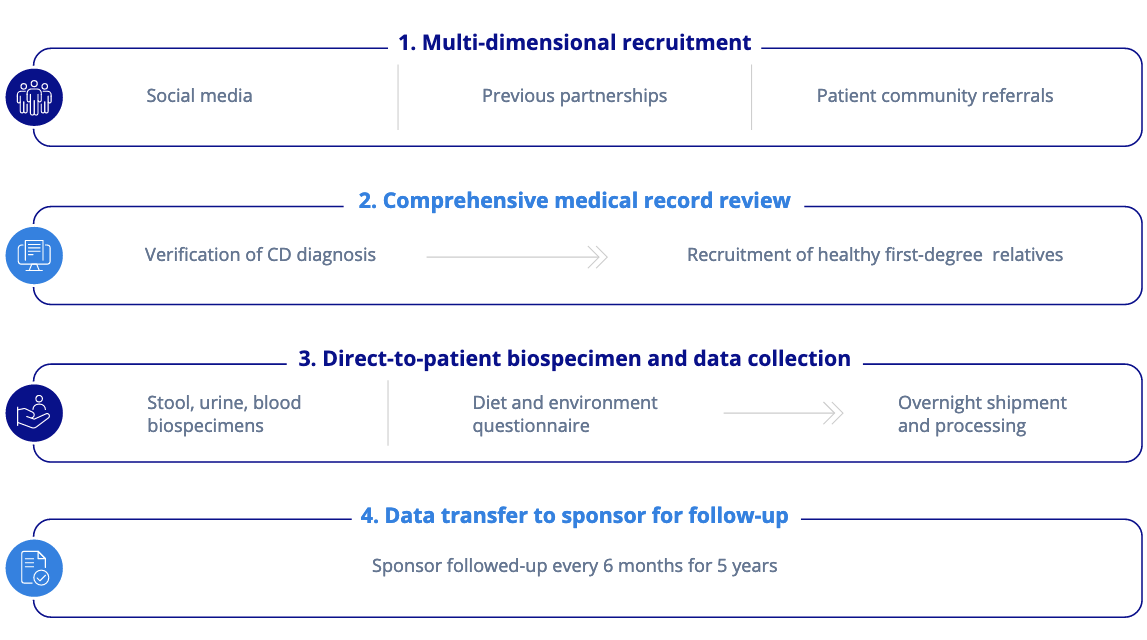
Easing Participation Burden
for Families with Crohn's Disease
THE GENETIC, ENVIRONMENTAL,
MICROBIAL (GEM) PROJECT
MISSION
To collect multiple specimen types from CD patients and their healthy first-degree relatives for genetic and biomarker analyses
CHALLENGES
Complex recruitment and eligibility criteria, requiring comprehensive medical record screening of CD patients and the subsequent recruitment of their relatives.
SOLUTION
Strategically targeted online campaigns and referrals from our patient member community resulted in our recruitment of three times as many participants over the sponsor's 100 study sites.
Familial Risk for Population-Based Cohort Selection
The increasing prevalence of Crohn's disease (CD), an inflammatory bowel disease, drives increased scientific interest in understanding its pathogenesis. Disease onset usually occurs under 30 years of age, and although the etiology remains unknown, evidence suggests that a combination of genetic, immune, environmental, and bacterial factors are of suspect.¹ Because first-degree relatives of CD patients are at higher risk of developing the disease when compared with the general population,² studying familial cohorts could provide valuable insights into the genetic and environmental factors contributing to CD.
The GEM Project
A global research study started in 2008; the GEM project aims to understand how CD develops, its associated triggers, and risk modification opportunities.³ To be successful, the project required a massive global recruitment effort of first-degree relatives of CD patients. Investigators would then track the healthy relatives over time, looking for changes in their environmental exposures, enteric microbial flora, and immune responses that may increase the risk of developing CD. As of July 2020, the GEM project website lists that more than 5,000 first-degree relatives have enrolled around the world, of which 95 have developed CD.³,⁴

Recruitment Ramp-Up
Initially, investigators were working with more than 100 clinical sites for recruitment, but logistics and participation burden of traveling to a clinical collection center hampered the study timeline. They turned to our direct-to-patient model to identify study participants and facilitate in-home specimen collection.
Sanguine took on the recruitment challenge in the U.S., outdoing other participating sites, including the Children's Hospital of Philadelphia, to recruit more than three times as many first-degree relatives to the GEM project.
Commitment
Participants
Biospecimens
Recruit and pre-screen CD patient first-degree relatives and perform two-day consecutive in-home visits for specimen collection
More than 700 clinically diagnosed CD patients answered our recruitment call; 63 of their healthy first-degree relatives between the ages of 6 and 35 years were enrolled
Stool, urine, and blood
How Did we Rise to the Challenge?
After the two consecutive in-home visits, study participants were transferred to the Crohn's and Colitis Foundation to facilitate 6-month follow-ups for their longitudinal study. Our multi-pronged recruitment approach and convenient direct-to-patient biospecimen collection earned Sanguine the recognition of being the top U.S. recruitment site for the GEM project in 2017.

REFERENCES
¹ Gajendran M, Loganathan P, Catinella AP, Hashash JG. A comprehensive review and update on Crohn's disease. Dis Mon 2018;64(2):20–57.
² Russell RK, Satsangi J. IBD: a family affair. Best Pract Res Clin Gastroenterol 2004;18(3):525–539.
³ Crohn's and Colitis Canada. The GEM Project. Available online: https://crohnsandcolitis.ca/Research/Funded-research/The-gem-project. Updated July 2020. Accessed April 12, 2021.
⁴ The GEM Project. The Crohn's and Colitis Canada GEM Project. Available online: http://www.gemproject.ca/. Updated 2021. Accessed April 12, 2021.


